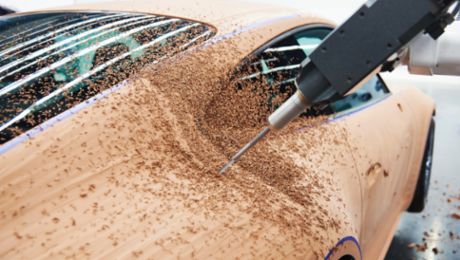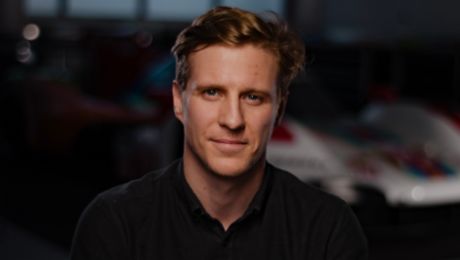“We are aware that we build sports cars for very different cultures,” says Peter Varga, Director Exterior Design at Porsche. New design ideas and artistic influences from around the globe are therefore incorporated into the design process of every new Porsche model.
Regular creative exchanges
An important source of such inspiration is the regular creative exchanges that take place in the design studio at the Weissach Development Centre. Team members invite creative minds from around the world to these sessions, as well as presenting interesting projects themselves. “These inputs and regular exchanges – deliberately kept separate from the everyday topics of the series-production design process – are extremely important for us,” says Varga. “Direct interaction works much better than having a conversation over a screen.”

Two very different personalities recently provided inspiration for the Porsche sports cars of the future in this way: Brazilian artist Adonis Alcici and Ukrainian product designer Kateryna Sokolova. Alcici lives in the Brazilian city of São Paulo. In Weissach, he shared how he developed a passion for motorsport as a child and, as a teenager, met members of the Porsche team for the first time at a Formula One race at Interlagos. This marked the beginning of a long-standing connection: Alcici has designed art cars for Porsche that were exhibited at Miami Art Week. He also designed the helmet worn by Porsche factory driver Felipe Nasr during the 2023 24 Hours of Le Mans.

In Weissach, he painted a black Macan together with Porsche designers. His signature style features arrow shapes, which emphasise the proportions and great dynamism of Porsche's racing and sports cars. “His style is incredibly relaxed and effortless,” says Varga.
Brazilian nonchalance meets German engineering expertise
Brazilian nonchalance meets German engineering expertise to precisely create the tension that Michael Mauer, Head of Style Porsche, sees as embodying a defining design principle. Three key words represent the brand identity of Porsche: focus, tension and purpose. Porsche offers iconic design. The design DNA of the sports cars is consistently evolved, thanks in part to inspirations like those from Alcici, who says “My art is about speed – and adrenaline.”
This evolution is a team effort in Weissach: designers, studio engineers, model builders and UX designers collaboratively shape the Porsche models of tomorrow. “Events like these creative exchanges help us to recognise trends early and gather important impulses from outside the automotive world,” explains Varga.
Trends have been set by the Ukrainian product designer Kateryna Sokolova, too. Sokolova presented the headphones that she designed for the musician Jean-Michel Jarre and the lights that hang in the Buddha Bar in New York when she visited the studio in Weissach. Her furniture is a highlight in extraordinary venues and architect-designed houses worldwide. During her creative exchange with the Porsche designers, Sokolova explained how she develops prototypes into design objects: starting with 100 variants, from which one ultimately prevails.
Sokolova's inputs have inspired the designers at Porsche, for example, in the selection of new materials and surfaces for Porsche interiors. In this way, art, design and sports car manufacturing mutually enrich each other.



